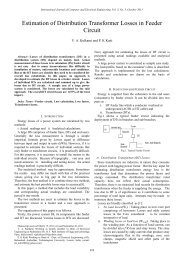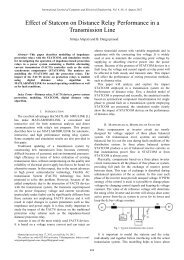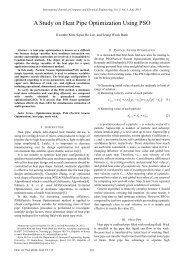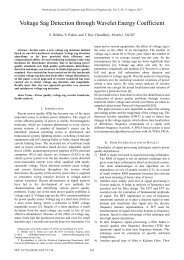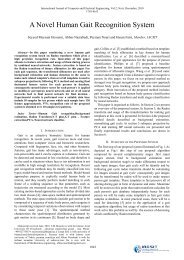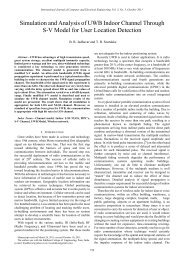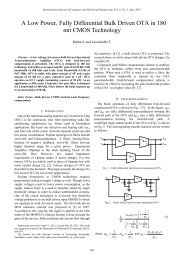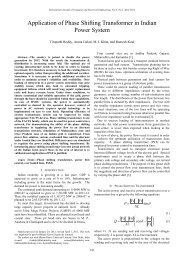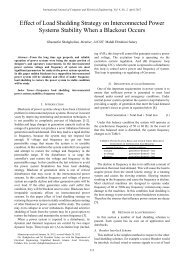Dynamic Finger Movement Tracking and Voice Commands ... - ijcee
Dynamic Finger Movement Tracking and Voice Commands ... - ijcee
Dynamic Finger Movement Tracking and Voice Commands ... - ijcee
Create successful ePaper yourself
Turn your PDF publications into a flip-book with our unique Google optimized e-Paper software.
International Journal of Computer <strong>and</strong> Electrical Engineering, Vol. 3, No. 4, August 2011<br />
<strong>Dynamic</strong> <strong>Finger</strong> <strong>Movement</strong> <strong>Tracking</strong> <strong>and</strong> <strong>Voice</strong><br />
Comm<strong>and</strong>s Based Smart Wheelchair<br />
Fahad Wallam <strong>and</strong> Muhammad Asif<br />
Abstract—many disable persons are able to operate a<br />
joystick to control the electric wheelchair but on the<br />
other h<strong>and</strong>, many people do not have the legerdemain<br />
necessary to operate a joystick. Moreover, many of them<br />
face difficulty to avoid obstacles. The aim of this paper is<br />
to implement a multi-control system to control the<br />
movement of the wheelchair by integrating finger<br />
movement tracking system, a small vocabulary speaker<br />
dependent based word recognition system <strong>and</strong> a group of<br />
monitoring sensors in order to avoid obstacles. Moreover,<br />
a joystick control system is also implemented in order to<br />
facilitate the patients that are able to use the joystick. The<br />
theme is accomplished by using a micro-controller with<br />
digital signal processor for isolated word recognition <strong>and</strong><br />
sets of sensors. The results are also given at the end of the<br />
paper.<br />
Index Terms—<strong>Finger</strong> movement tracking, speech recognition,<br />
gesture recognition, fingerprints.<br />
I. INTRODUCTION<br />
Despite rapid technological <strong>and</strong> scientific progress in<br />
devices for persons with disability, there has been very little<br />
advancement in the wheelchair design over the last 200 years.<br />
The folding wheelchair came in 1933, <strong>and</strong> powered<br />
wheelchairs were developed in the early 1970s [1]. New<br />
materials such as plastics, fiber-reinforced composites <strong>and</strong><br />
beryllium-aluminum alloys have found their way into the<br />
design <strong>and</strong> manufacturing of lighter, stronger <strong>and</strong> more<br />
reliable wheelchairs [2].<br />
Various electric wheelchairs with computer-controlled<br />
mechanism have been developed in the recent years such as<br />
“WALKY”, “Tin Man”, “CALL smart chair”, <strong>and</strong><br />
“Nav-Chair” [3-6]. These electric wheelchairs may use a<br />
broad variety of sensors such as ultrasonic <strong>and</strong> infrared<br />
sensors, cameras, encoders, accelerometers <strong>and</strong> gyroscopes,<br />
with several desired control devices such as joystick,<br />
pressure pads, etc in order to provide ease <strong>and</strong> comfort [7].<br />
Electric wheelchair systems integrated with customized user<br />
interfaces, various sensors, <strong>and</strong> different types of controllers,<br />
can make the function <strong>and</strong> controlling of a wheelchair much<br />
simpler <strong>and</strong> safer <strong>and</strong> make it more stable <strong>and</strong> h<strong>and</strong>y for<br />
disabled persons [8]. Appropriate algorithms for controlling<br />
Manuscript received January 9, 2011; revised July 11, 2011.<br />
Fahad Wallam is with Electronic Engineering Department, Sir Syed<br />
University of Engineering <strong>and</strong> Technology, Karachi (e-mail:<br />
fwallam@gmail.com).<br />
Muhammad Asif is with Electronic Engineering Department, Sir Syed<br />
University of Engineering <strong>and</strong> Technology, Karachi (e-mail:<br />
muasif@ssuet.edu.pk).<br />
the wheelchair aid the user in avoiding obstacles such as<br />
walls, moving obstacles like people <strong>and</strong> other wheelchairs,<br />
planning collision-free paths <strong>and</strong> moving safely in jumbled<br />
environments without taking much of the user input [9-12].<br />
In the joystick based electric wheelchairs, the joystick<br />
serving as the main control interface for the wheelchairs, has<br />
the advantage of detailed movement direction <strong>and</strong> speed<br />
control, it has the disadvantages of requiring complex wrist<br />
movement that becomes difficult for certain disabled persons<br />
<strong>and</strong> aged ones <strong>and</strong> may result in inadequate <strong>and</strong> improper<br />
control leading to accidents [13,14]. On the other h<strong>and</strong> there<br />
are persons with disability that can operate the joystick very<br />
conveniently <strong>and</strong> safely. It is therefore useful to consider a<br />
control system for the electric wheelchair that contains both<br />
the joystick based control as well as non-joystick based<br />
control systems that do not need the complex wrist movement,<br />
in order to fulfill the disabled persons need.<br />
This paper proposes a new approach to the same problem<br />
of a better control, as discussed above, for the wheelchair by<br />
integrating both the joystick <strong>and</strong> non-joystick based controls<br />
into the wheelchair along with the group of sensors <strong>and</strong><br />
actuators with gears. The non-joystick based control systems<br />
include the finger movement tracking control system <strong>and</strong><br />
voice comm<strong>and</strong> control system. These three controls help<br />
almost all categories of disabled persons to derive the<br />
wheelchair easy <strong>and</strong> safe.<br />
In the history of technology, few inventions such as<br />
micro-controllers <strong>and</strong> digital signal processors have changed<br />
the world revolutionary. The exponential increase in the<br />
computer power while decreasing cost <strong>and</strong> size of the<br />
micro-controllers <strong>and</strong> processors have made our life not easy<br />
but fill full of charm in it. Because of their advantages, the<br />
TMS320C6711 digital signal processor (DSP) <strong>and</strong> AVR<br />
micro-controller are used in this work. The DSP is used for<br />
implementing speaker dependent speech recognition system<br />
for capturing vocal comm<strong>and</strong>s for the wheelchair <strong>and</strong> the<br />
micro-controller is used to track the finger movement signals<br />
<strong>and</strong> captures the joystick signals as well. The<br />
micro-controller also serves as the main interface among the<br />
three control systems <strong>and</strong> the sensors <strong>and</strong> actuators.<br />
The rest of the paper is organized as follows: Section II<br />
outlines a general idea of the overall system operation. The<br />
detailed discussion of the system is giving in Section III. In<br />
this section, the three control systems, finger movement<br />
tracking, voice comm<strong>and</strong> <strong>and</strong> joystick controls, are explained<br />
in very detail. Furthermore, a discussion about monitoring<br />
sensors is also presented. Finally, the results <strong>and</strong> conclusion<br />
are presented in Section IV <strong>and</strong> V respectively<br />
497
International Journal of Computer <strong>and</strong> Electrical Engineering, Vol. 3, No. 4, August 2011<br />
II. SYSTEM OVERVIEW<br />
In this work, micro-controller, digital signal processor,<br />
controlling circuitry <strong>and</strong> sensors are implemented on a simple<br />
wheelchair along with actuators. The main theme is to control<br />
the wheelchair according to the signals from the input source.<br />
The input source can be the voice, the finger movement<br />
signals or the joystick. This is illustrated in figure 1. The<br />
switches are provided to select the appropriate input signal<br />
source.<br />
The TMS320C6711 DSP kit is used for speech recognition<br />
task. It processes the speech signals <strong>and</strong> generates<br />
appropriate analog signals to comm<strong>and</strong> the micro-controller<br />
so as to control the motion of the wheelchair according to the<br />
word spoken. Four words, Left, Right, Up <strong>and</strong> Stop, are used<br />
as voice comm<strong>and</strong>s<br />
Special sensors are used to track the movement of the<br />
fingers. These sensors generate analog signals, which are<br />
translated by the micro-controller to control the wheelchair.<br />
The ultrasonic sensors are used to detect the obstacles while<br />
optical encoders enable the system to control the speed of the<br />
chair conveniently. The micro-controller’s final decision is<br />
based on the signals received from the monitoring sensors so<br />
as not to put the user in danger.<br />
III. SYSTEM CONTROL<br />
Figure 1: Block Diagram of the System<br />
The wheelchair can be driven either by selecting the finger<br />
movement tracking control, the voice comm<strong>and</strong> control or<br />
the joystick control. There are three switches given to select<br />
one control system at any time for driven the wheelchair.<br />
When a particular control switch is selected, it gives interrupt<br />
to the micro-controller <strong>and</strong> the micro-controller adjusts itself<br />
for the control-system selected.<br />
A. FINGER MOVEMENT TRACKING CONTROL<br />
SYSTEM:<br />
In this work, movement tracking is chosen because of its<br />
superiority over gesture recognition, as it has no boundaries<br />
in order to capture any motion rather than to wait for a special<br />
sign being made in gesture recognition. In gesture<br />
recognition, gestures are usually preprogrammed in the<br />
application (i.e., a finite set of very specific body positions)<br />
<strong>and</strong> the user is trained to use these predefined gestures to<br />
control the system. Also, computer recognition of h<strong>and</strong><br />
gestures is difficult in complex scenes [15].<br />
The gestures are static, discrete, <strong>and</strong> restrictive. As a<br />
difference, movement tracking involves constant monitoring<br />
<strong>and</strong> dynamic <strong>and</strong> continuous tracking of the user who uses a<br />
series of movements to continue with the application. In<br />
movement tracking, the application is to be trained instead of<br />
the user. It emphasizes the natural interaction between the<br />
user <strong>and</strong> the application. To achieve the natural interaction,<br />
the application must learn to adapt the user’s movement<br />
rather than the user trying to satisfy the requirements <strong>and</strong><br />
limitations of the application.<br />
In this system, the wheelchair can be controlled by a<br />
combination of three fingers. One finger controls the speed of<br />
the wheelchair while the other two fingers control the<br />
directions of the wheelchair. There is flexibility that we can<br />
use only two fingers instead of three to control the direction<br />
while letting the system to control the speed automatically.<br />
For the purpose of tracking the movement of fingers, the<br />
flex-sensors are used. The sensors are fastened at the finger<br />
position on the gloves as shown in figure 2. The resistive<br />
bend (flex) sensors are the sensors that change their<br />
resistance when they are bent. A flat flex-sensor has a<br />
resistance of about 10,000 Ohms (that is, at 0 degree, its<br />
resistance is 10,000 Ohms.) As the sensor is bent, its<br />
resistance increases to about 35,000 Ohms at 90 degrees as<br />
shown in figure 3 [16].<br />
The flex-sensors provide the bending angle information of<br />
the fingers to the system. The system compares this<br />
information with those obtained during training <strong>and</strong> finds a<br />
comm<strong>and</strong> to send to the actuators to control the wheelchair.<br />
After verifying that there is no conflict between the comm<strong>and</strong><br />
it ready to send to the chair <strong>and</strong> the data obtained from the<br />
monitoring sensors, it sends the comm<strong>and</strong> to the actuator so<br />
as the chair to act accordingly. The block diagram for the<br />
system is presented in figure 4.<br />
B. VOICE COMMAND CONTROL SYSTEM:<br />
Speech recognition has been actively studied since 1960s,<br />
however recent developments in computer <strong>and</strong> digital signal<br />
processing technology have improved speech recognition<br />
capabilities. Although, now days, speech recognition is a<br />
very complex problem. It involves many techniques <strong>and</strong><br />
algorithms, which require high computational requirements<br />
[17].<br />
Figure 2: Gloves fastened with Resistive Bend Sensors.<br />
After the introduction of specialized digital signal<br />
processors, the real-time digital signal processing is more<br />
easily implemented than before [18]. However, speech<br />
recognition has a very important role in many application<br />
498
International Journal of Computer <strong>and</strong> Electrical Engineering, Vol. 3, No. 4, August 2011<br />
fields [19–22]. Various studies in the last few years show<br />
good results in both research <strong>and</strong> commercial applications<br />
than as before [23–25].<br />
FINGER<br />
MOVEMENT<br />
SIGNALS<br />
MONITORING<br />
SENSORS<br />
RECOGNITION<br />
PHASE<br />
DECISION<br />
PHASE<br />
REFRENCE<br />
SIGNALS<br />
ENCODERS<br />
SYSTEM<br />
TRAINING<br />
ACTUATORS<br />
Figure 4: Block Diagram representing <strong>Finger</strong> <strong>Movement</strong><br />
<strong>Tracking</strong> System.<br />
Figure 3: Flex Sensor <strong>and</strong> its Characteristics<br />
The model of the speech recognition used in the voice<br />
comm<strong>and</strong> control system, implemented on TMS320C6711<br />
DSP kit, is shown in figure 5. The signals from the<br />
microphone are first passed from the analog low pass filter of<br />
the second order with a cut off frequency of 3KHz <strong>and</strong><br />
amplifier <strong>and</strong> then digitizes through analog to digital<br />
converter integrated in the kit. The digitized signals are then<br />
passed through the word detection algorithm. Here, the<br />
processor calculates the average energy of the noise in the<br />
environment during training <strong>and</strong> uses it as a threshold point<br />
for detecting the start of the word.<br />
1<br />
2999<br />
E = ∑ xi<br />
3000 i=<br />
0<br />
z (1)<br />
When the energy of the incoming samples exceed from<br />
this threshold value, the system thinks as the word is being<br />
spoken <strong>and</strong> captures only the first 3000 incoming samples.<br />
The captured signals are then passed through normalization<br />
algorithm because sometimes we speak loudly <strong>and</strong><br />
sometimes we speak gently. The energy of the word spoken<br />
loudly is much more greater than that of spoken gently. So,<br />
there is a need for normalization. One method of<br />
normalization that is used in this work is to determine the<br />
maximum value in the samples <strong>and</strong> then divide each sample<br />
with this value. After normalization, the samples are<br />
multiplied with a certain gain value.<br />
The signals are then passed through five digital FIR b<strong>and</strong><br />
pass filters whose b<strong>and</strong> pass frequencies are shown in the<br />
block diagram. The Blackman window is used for the filter<br />
<strong>and</strong> the function [26] is given in figure 4.<br />
The samples from each B<strong>and</strong> Pass filter are grouped into<br />
frames. The length of each frame is 200 (that is, there are 200<br />
samples in each frame). The total number of samples is 3000<br />
therefore the number of frames for each filter is 15<br />
(3000/200=15).<br />
⎛2πn⎞ ⎛4πn⎞<br />
W( n)<br />
= 0.42 + 0.5cos + 0.08cos<br />
(2)<br />
⎜⎝ N ⎠⎟<br />
⎜⎝ N ⎟⎠<br />
The fingerprint generation is the most important step in the<br />
speech recognition task. In this step, the samples are squared<br />
<strong>and</strong> accumulated together in each frame from each filter. It is<br />
more easily understood by having look at the following<br />
equation:<br />
199<br />
2<br />
F ( N) = ∑ x ( l)<br />
(3)<br />
K<br />
K,<br />
N<br />
l=<br />
0<br />
where, N represents the number of frames <strong>and</strong> N=1,2,3…15<br />
as there are 15 frames from each filter; K represents the b<strong>and</strong><br />
pass filters <strong>and</strong> K=1,2…6 as there are 6 b<strong>and</strong> pass filter.<br />
Likewise, the index l=0 to 199 represents the samples in each<br />
frame, as there are 200 samples in each frame. In this way,<br />
there are 15 fingerprints (one for each frame) from each filter<br />
<strong>and</strong> as there are 6 filters so the total number of fingerprints<br />
are 90 (15*6=90) for each spoken word.<br />
In the fingerprints processing step, the fingerprints of the<br />
spoken word are compared with fingerprints of the all the<br />
words in the dictionary that are obtained during training. Two<br />
techniques are combined for achieving the recognition task.<br />
First, the system calculates the corresponding difference<br />
between the fingerprints of the spoken word <strong>and</strong> the<br />
fingerprints of each word in the dictionary as:<br />
Diff ( L) = Fd ( L) − Fs ( L)<br />
(4)<br />
KM , KM ,<br />
K<br />
where, L represents the number of fingerprints from each<br />
filter <strong>and</strong> L=1,2,3…15; K represents the b<strong>and</strong> pass filter <strong>and</strong><br />
K=1,2…6; Fd represents the fingerprints of the M th word in<br />
the dictionary where M=1,2…4 as in this work four words<br />
(Left, Right, Up <strong>and</strong> Stop) are stored in the dictionary. Also,<br />
Fs represents the fingerprints of the spoken word. As there<br />
are four words so the result is four sets of elements with each<br />
set consist of 90 elements. Then, the values of all four sets are<br />
compared correspondingly with one another <strong>and</strong> the value<br />
with the smallest magnitude is marked. Finally, the marked<br />
values are counted <strong>and</strong> the set with the largest value is<br />
selected.<br />
499
International Journal of Computer <strong>and</strong> Electrical Engineering, Vol. 3, No. 4, August 2011<br />
ANALOG FILTER &<br />
WORD<br />
DETECTION<br />
& FIRST 3000<br />
BAND PASS FILTER 0<br />
300-3000 Hz<br />
BAND<br />
PASS<br />
FILTER<br />
BAND<br />
PASS<br />
FILTER 3<br />
BAND<br />
PASS<br />
FILTER 5<br />
FRAMING<br />
BAND<br />
PASS<br />
FILTER<br />
BAND<br />
PASS<br />
FILTER<br />
BAND<br />
PASS<br />
FILTER<br />
SQUARING EACH TERM IN EACH<br />
FRAME FOR EACH FILTER<br />
ACCUMULATOR<br />
FINGER PRINTS PROCESSING<br />
MICROPH<br />
NORMALIZA<br />
GAIN<br />
discards the spoken word <strong>and</strong> wait for the next voice<br />
comm<strong>and</strong>.<br />
C. JOYSTICK CONTROL SYSTEM:<br />
The digital joystick is interfaced to the micro-controller by<br />
using the interfacing circuitry. The interfacing circuitry<br />
consists of IC “74C922” along with the supporting<br />
components. The IC is interfaced to the micro-controller in<br />
the hardware interrupt mode. In this mode, whenever there is<br />
any activity on the joystick, the IC sends an interrupt signal to<br />
the micro-controller <strong>and</strong> also gives the binary input for that<br />
particular movement to the micro-controller if the joystick<br />
control mode has been selected as the control system for the<br />
wheelchair.<br />
D. MONITORING SENSORS:<br />
Sets of ultrasonic sensors (transmitter <strong>and</strong> receiver) are<br />
placed in the front as well as at the left <strong>and</strong> right sides of the<br />
wheelchair in order to avoid obstacles <strong>and</strong> to maintain a safe<br />
distance from the obstacles.<br />
Ultrasonic sensors are chosen as monitoring sensors<br />
because it is not light sensitive as infrared sensors are. The<br />
other property of ultrasonic sensors is to produce mechanical<br />
vibrations so as to reflect ultrasonic waves from transparent<br />
obstacles such as glass. For moving obstacles like people,<br />
with the help of these ultrasonic sensors, the system measures<br />
the distance of the wheelchair from the obstacles <strong>and</strong> by<br />
continuously measuring the distance, the system reduces the<br />
speed of the chair until the obstacle disappears from its path<br />
or stops the chair if a safe distance is reached. The system<br />
calculates the distance of the wheelchair from the obstacle by<br />
using the following formula:<br />
v*<br />
t<br />
D = (6)<br />
2<br />
where, D is the distance of the wheelchair from the obstacle,<br />
v is the velocity of sound (340 m/s) <strong>and</strong> t is the time from<br />
sending an ultrasonic pulse to receiving the very pulse.<br />
The second technique used in this work is to calculate the<br />
correlation between the spoken word <strong>and</strong> all the four words<br />
in the dictionary. As a result, four values are generated. All<br />
these four values are compared with one another <strong>and</strong> the<br />
value with the largest magnitude is selected. The coefficient<br />
of correlation [27] is given as:<br />
μ =<br />
FINGER<br />
PRINTS<br />
IN<br />
ADC<br />
MICRO-<br />
CONTROLLER<br />
Figure 5: Block Diagram representing<br />
Speech Recognition System.<br />
n( ∑xy) −( ∑x)( ∑ y)<br />
⎡<br />
{ ( ) ( ) ( ) ( ) } 1<br />
2 2 2<br />
n x x ⎤*<br />
⎡n y y<br />
2 ⎤<br />
⎢ ∑ − ∑ ⎥ ⎢ ∑ − ∑ ⎥<br />
2<br />
⎣ ⎦ ⎣ ⎦<br />
where, x represents the fingerprints of the dictionary word<br />
<strong>and</strong> y represents the fingerprints of the spoken word.<br />
If the two results point to the same dictionary word, the<br />
system thinks as it recognizes the word otherwise, the system<br />
(5)<br />
IV. RESULTS & DISCUSSIONS<br />
The system is interfaced <strong>and</strong> checked with the Personal<br />
Computer (PC). The Matlab is used for the simulation on<br />
computer. The microphone along with the analog filter <strong>and</strong><br />
amplifier is connected with the PC. Also, the finger<br />
movement tracking system (that includes sensory gloves,<br />
micro-controller <strong>and</strong> ADC) is also interfaced with the PC<br />
using serial interface.<br />
The table 1 represents the angles obtained during the<br />
training of finger movement tracking system. In this test, two<br />
fingers <strong>and</strong> a thumb are used to control the wheelchair. The<br />
thumb controls the speed while the other two fingers control<br />
the direction of the wheelchair. This table shows that the<br />
wheelchair operates if finger position appears between these<br />
angles <strong>and</strong> if any of the two fingers appears in the angle range<br />
set for the other during training, the system comm<strong>and</strong>s to stop<br />
the wheelchair <strong>and</strong> consider it as a bad comm<strong>and</strong>.<br />
In the voice comm<strong>and</strong> control system, the samples of the<br />
words after passed through accumulator (fingerprints<br />
generation) are stored in the memory during training <strong>and</strong><br />
called them as dictionary words. The sample words include<br />
500
International Journal of Computer <strong>and</strong> Electrical Engineering, Vol. 3, No. 4, August 2011<br />
left, right, up <strong>and</strong> stop. The sample length is selected as 3000<br />
which are captured at a sampling rate of 8000 samples per<br />
second that is the voice is recorded for 0.375 seconds<br />
(3000/8000=0.375) which is the enough time to say a<br />
complete word.<br />
SPEED LEFT RIGHT STOP<br />
Thumb’s<br />
Angle<br />
0°-90° ___ ___<br />
1 st<br />
<strong>Finger</strong>’s<br />
Angle<br />
2 nd<br />
<strong>Finger</strong>’s<br />
Angle<br />
TABLE 1: TESTING RESULTS<br />
501<br />
___ 30°-55°<br />
Angle<br />
other than<br />
___<br />
30°-55°<br />
Angle<br />
other than<br />
35°-60°<br />
35°-60°<br />
The<br />
Wheelchair<br />
will be<br />
stopped<br />
other wise.<br />
The results obtained show a prototype that fulfills a large<br />
degree of the requirements of people who need a wheelchair<br />
in order to be able to move around. It may only require the<br />
help of a person to configure the system initially.<br />
V. CONCLUSION & FUTURE WORKS<br />
Recent improvements in the technology are making lives<br />
easier for everybody. This work is to help the disabled<br />
persons by implementing joystick, finger movement tracking<br />
<strong>and</strong> voice comm<strong>and</strong> based control system for the wheelchair.<br />
This paper addresses a hardware design of a multi-control<br />
system, implemented using AVR micro-controller act as the<br />
main controller <strong>and</strong> TMS320C6711 DSP kit, which has a<br />
large on board memory to store sound parameters, is used for<br />
speech recognition task. A very simple real time algorithm<br />
has been developed for the speech recognition task <strong>and</strong> bends<br />
resistive sensors, which are used for the finger movement<br />
tracking, interfaced to the micro-controller. Finally, the<br />
wheelchair underst<strong>and</strong>s the signals coming from the control<br />
system <strong>and</strong> reacts accordingly. The efficiency of the voice<br />
comm<strong>and</strong> control system can be further improved by<br />
implementing neural network based algorithms.<br />
Figure 6: <strong>Finger</strong>prints of four different words<br />
ACKNOWLEDGEMENT<br />
Authors would like to thank Dr. Muhammad Naim Wallam<br />
for his kind support without which this work would not be<br />
possible. Special thanks to Ms. Samreen Amir <strong>and</strong> Mr. Fawad<br />
Shaukat, Assistant professors at Electronic Engineering<br />
Department, Sir Syed University of Engineering <strong>and</strong><br />
Technology, for their guidance <strong>and</strong> support for writing <strong>and</strong><br />
organizing this work.<br />
REFRENCES<br />
[1] Teitelman, “De-h<strong>and</strong>icapping the h<strong>and</strong>icapped. Forbes”, September<br />
24, 1984.<br />
[2] C.A. McLaurin <strong>and</strong> P. Axelson, “Wheelchair st<strong>and</strong>ards: an overview”,<br />
Journal of Rehabilitation Research <strong>and</strong> Development (Clinical<br />
Supplement), 1990, 27(2): pp. 100-103.<br />
[3] J.D. Nisbet, I.R. Loudon <strong>and</strong> J.P. Odor, “The CALL Center smart<br />
wheelchair”. In Proceedings of 1 st International Workshop on Robotic<br />
Applications to Medical <strong>and</strong> Health Care, 1988, Ottawa, Canada.<br />
[4] D.A. Bell, J. Borenstein, S. Levine, Y. Koren <strong>and</strong> L.A. Jaros, “An<br />
assistive navigation system for wheelchairs based upon mobile robot<br />
obstacle avoidance”. In Proceedings of the IEEE International<br />
Conference on Robotics <strong>and</strong> Automation, May 8-13, 1994, San Diego,<br />
CA, pp. 2012-2017.<br />
[5] D. Miller <strong>and</strong> M. Slack, “Design <strong>and</strong> testing of a low-cost robotic<br />
wheelchair prototype”, Autonomous Robots, 1995, 2(1): pp. 77-88.<br />
[6] Håkan Neveryd <strong>and</strong> Gunnar Bolmsjö, “WALKY, A mobile robot<br />
system for the disabled”. In Proceedings of the 4 th International<br />
Conference on Rehabilitation Robotics (ICORR), June, 1994,<br />
Wilmington, Delaware, USA, pp. 137-141.
International Journal of Computer <strong>and</strong> Electrical Engineering, Vol. 3, No. 4, August 2011<br />
[7] M3S: A general-purpose multiple-master multiple-slave intelligent<br />
interface for the rehabilitation environment, International St<strong>and</strong>ards<br />
Organization, 1995.<br />
[8] J. M.Ford <strong>and</strong> S. J. Sheredos, “Ultrasonic head controller for powered<br />
wheelchairs”. Journal Of Rehabilitation Research <strong>and</strong> Development,<br />
1995, 32(3): pp. 280-284.<br />
[9] P.F. Muir <strong>and</strong> C.P., “Neuman, Kinematic modeling for feedback<br />
control of an omni-directional wheeled mobile robot”, In I.J. Cox <strong>and</strong><br />
G.T. Wilfong (eds.) Autonomous Robot Vehicles, Springer Verlag, 1990,<br />
pp. 25-31.<br />
[10] D.A. Bell, S.P. Levine, Y. Koren, L.A. Jaros <strong>and</strong> J. Borenstein, “An<br />
identification technique for adaptive shared control in human-machine<br />
systems”. In Proceedings of the 15th Annual International Conference<br />
of the IEEE Engineering in Medicine <strong>and</strong> Biology Society, October<br />
1993, San Diego, CA, pp. 1299-1300.<br />
[11] J. Borenstein <strong>and</strong> Y. Koren, “Tele-autonomous guidance for mobile<br />
robots”, IEEE Transactions on Systems, Man <strong>and</strong> Cybernetics, 1991,<br />
17(4), pp. 535-539.<br />
[12] U. Borgolte, R. Hoelper, H. Hoyer, H. Heck, W. Humann, J. Nezda, I.<br />
Craig, R. Valleggi <strong>and</strong> A. M. Sabatini, “Intelligent control of a<br />
semi-autonomous omni-directional wheelchair”. In Proceedings of the<br />
3rd International Symposium on Intelligent Robotic Systems `95 (SIRS<br />
`95) , July 10-14, 1995, Pisa, Italy, pp. 113-120.<br />
[13] J. Kono <strong>and</strong> J. Inada, “Special Characteristics of Tooth Brushing<br />
<strong>Movement</strong> in Elementary School <strong>and</strong> the Elderly”. The Japanese<br />
Society for Dental Health, Vol.58, No.3, pp 91-92.<br />
[14] S. Yokota, H. Hashimoto, Y. Ohyama <strong>and</strong> J. She, “Electric wheelchair<br />
controlled by human body motion”, Journal of Robotics <strong>and</strong><br />
Mechatronics, 2010, Vol. 22, No. 4, pp 439-446.<br />
[15] V.I. Pavlovic, R. Sharma, <strong>and</strong> T.S. Huang, “Visual interpretation of<br />
h<strong>and</strong> gestures for human-computer interaction: A review”, IEEE<br />
Transactions on Pattern Analysis <strong>and</strong> Machine Intelligence, July 1997,<br />
vol. 19, pp. 677-695.<br />
[16] The datasheet of the spectrasymbol’s flex sensor product.<br />
[17] M. Petriska, D. Považanec, P. Fuchs, “Speech control for car using the<br />
TMS320C6701 DSP”, 10 th International Scientific Conference,<br />
Bratislava, 2000, pp. 97-100.<br />
[18] G. Bertini <strong>and</strong> M. Magrini, “A Prototype Lab Box with DSK’C6711/13<br />
for Rapid DSP Algorithm Development”, White Paper, Institute of<br />
Science <strong>and</strong> Technology of Information (ISTI-CNR) National Research<br />
Council Pisa, October 2005, Italy.<br />
[19] F. Beritelli, S. Casale, <strong>and</strong> A. Cavallaro, “A Robust <strong>Voice</strong> Activity<br />
Detector for Wireless Communications Using Soft Computing”, IEEE<br />
Journal on Selected Areas in Communications (JSAC), Special issue on<br />
Signal Processing for Wireless Communications, 1998, vol. 16, no. 9.<br />
[20] R.I. Mabo, <strong>and</strong> W.R. Donadson,“Zero Crossing Measurements for<br />
Phonetic Recognition of Speech”, IEEEASSP, vol. 24, no. 1.<br />
[21] R.D. Schraft, C. Schaeffer, <strong>and</strong> T. May, “Care-O-bot: The Concept of a<br />
System for Assisting Elderly or Disabled Persons in Home<br />
Environments”, In Proceedings of the 24th Annual Conference<br />
IECON98, 1998, vol. 4, pp. 2476–2481.<br />
[22] J. Huang, N. Ohnishi, <strong>and</strong> N. Sugie, “Sound Localization in<br />
Reverberant Environment Based on the Model of the Precedence<br />
Effect”, IEEE Transaction on Instrumentation <strong>and</strong> Measurement, 1997,<br />
vol. 46, pp. 842–846.<br />
[23] E. Shlomot, V. Cuperman, <strong>and</strong> A. Gersho, “Hybrid Coding of Speech<br />
at 4 Kbps”. In Proceeding of IEEE Workshop on Speech Coding for<br />
Telecommunication, Pocono Manor, PA, USA, September 1997, pp.<br />
37–38.<br />
[24] T. Wang, <strong>and</strong> V. Cuperman, “Robust Voicing Estimation with<br />
<strong>Dynamic</strong> Time Warping”. In Proceeding of IEEE International<br />
conference on Acoustic, Speech <strong>and</strong> Signal Processing, Seattle, WA,<br />
USA, May 1998, pp. 533–536.<br />
[25] A. Rao, K. Rose <strong>and</strong> A. Gersho, “Deterministically Annealed Design of<br />
Speech Recognizers <strong>and</strong> Its Performance on Isolated Letters”,<br />
Proceedings of the 1998 IEEE International Conference on Acoustics,<br />
Speech <strong>and</strong> Signal Processing, Seattle, WA, USA, May 1998, pp.<br />
461–464.<br />
[26] E.C. Ifeachor, <strong>and</strong> B.W. Jervis, Digital Signal Processing: A Practical<br />
Approach, second edition, Pearson Education, 2002, pp. 352-356.<br />
[27] N.A. Weiss, Introductory Statistics, seventh edition, Pearson<br />
Education, 2005, pp. 724-727.<br />
502


